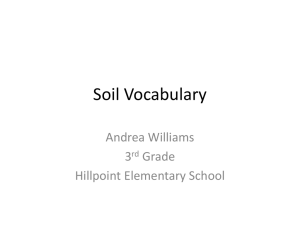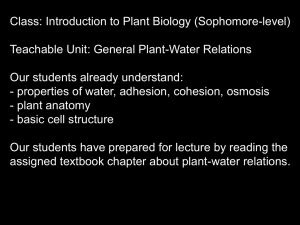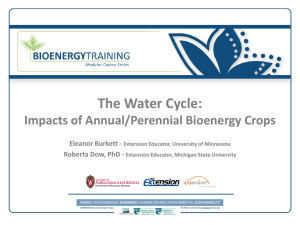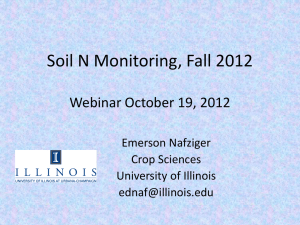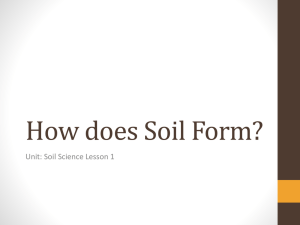3.4 The soil system
advertisement
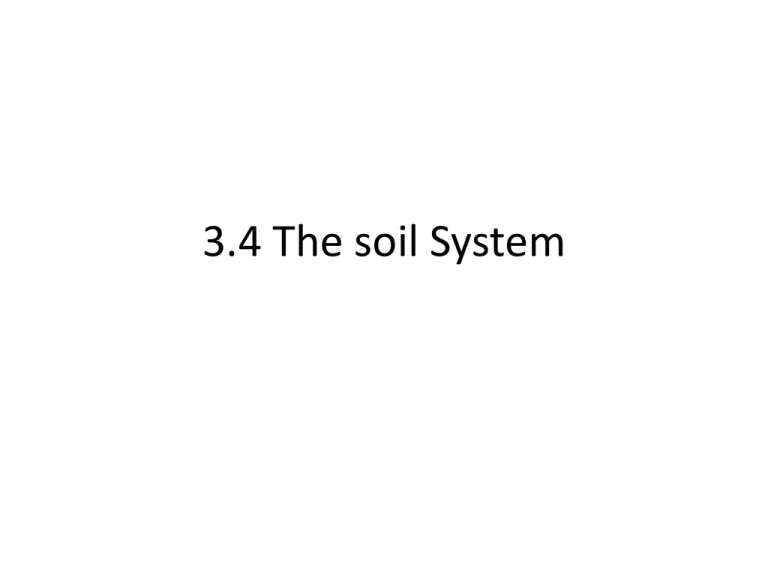
3.4 The soil System Structure of a soil Insoluble rock particles eg. gravel, sand, clay. Soluble particles eg. Nitrates, minerals Provides a skeleton of the soil. May come from the bedrock or be washed in from elsewhere. Soil organisms eg worms. Break down the dead organic matter. Aerate and drain the soil. Microorganisms, add or remove nutrients eg nitrates. Air, mainly N and O2 . Allow respiration for soil organisms and plant roots Water seeps down from rain or up from underground by capillary action. Moves soluble minerals around in the soil. Humus. Dead organic (mostly plant or animal) matter that is decaying. This returns minerals that where taken originally from the soil http://www.dse.vic.gov.au/dpi/vro/vroimages.nsf/Images/soilhealth_soil_structure/$File/soilhealth_soil_structure.gif • O – Leaf litter and dead organics. • A – layer with a mix of humus from above and minerals from below with many living organisms eg fungi, bacteria, worms… • E – region where minerals and organic matter have been leached leaving silica behind. • B - layer where soluble minerals and organic matter from above ends up. • C – Weathered bed rock, breaking into smaller and smaller particles. • R - Bedrock http://www.enchantedlearning.com/geology/soil/soillayers.GIF Soil Processes - Translocation • The movement of water within the soil - it can be either up or down. Water http://www.enchantedlearning.com/geology/soil/soillayers.GIF Soil Processes - Salinization • In dry climates, where evaporation is higher than precipitation, water moves up the soil taking dissolved Water minerals with it and depositing them on the surface. http://www.enchantedlearning.com/geology/soil/soillayers.GIF Soil Processes - Leaching Water • In wet regions, where there more precipitation than evaporation, the water moves down towards the bedrock taking dissolved minerals away from the surface. http://www.enchantedlearning.com/geology/soil/soillayers.GIF Soil Processes - Podsolization Water • In very wet regions, where there lots more precipitation than evaporation, and there is extreme leaching of the minerals to make the soil acidic with a nutrient poor bleached ‘A horizon’ and a very red ‘B horizon’ full of Iron oxide http://www.enchantedlearning.com/geology/soil/soillayers.GIF Soil Processes - Gleying • When the water cannot drain away the soil becomes water logged and the air spaces in the soil fill and so become poor in oxygen making a very blue/grey soil– eg a rice paddy. Tends to become nitrate poor due to nitrifying bacteria needing oxygen to create nitrates. Microsoft Clip art Soil Processes - Ferallitization • Tropical soils become very red because of podsolization speeded up by high temperatures. When clay breaks down to silica it gets leached away leaving Iron and aluminium oxides behind. Microsoft Clip art Activity • Make a systems diagram to show the movement of nutrients coming from water, organic matter and minerals through the soil system. Show the transfers and transformations and label the processes. Living biomass Assimilation Detritus /Humus Soil Jill Rutherford - Environmental Systems and Societies Course Companion (Page 230)– Oxford University Press Bedrock Different types of soil • Clay particles <0.002mm diameter • Silt particles 0.002 – 0.005mm diam. • Sand particles 0.005mm + diameter Think colours! http://www.atpm.com/9.08/images/design-color_triangle.gif http://www.sciencebuddies.org/mentoring/project_ideas/EnvSci_img014.jpg Properties of soil types Sand Loam Clay Mineral content High Relatively low due to higher organic content High Drainage High – big particles give big spaces so water flows easily Intermediate Low – small particles sit close together leaving little space for water to flow Water holding capacity Air spaces Low Intermediate High High Intermediate Low Biota – Amount of Living stuff! Ability to hold organic matter Low – not enough water High – some air and some water available Low – not enough air Poor – particles pass through the big gaps easily Good Poor – particles wash of the surface without penetration. Primary productivity Very Limited High Some but Limited Soil Degradation - Overgrazing Allowing animals to eat more than the area can sustainably produce. Exposes the soil to erosion as animals start to eat not only leaves but also roots. Rabbits and goats are big culprits Microsoft Clip art Soil Degradation - Deforestation Increased need for farm land and wood for building leads to more trees being cut down than are being planted. This removes top cover and roots, reduces humus build up and therefore leads to soil deterioration and erosion. Microsoft Clip art Soil Degradation – unsustainable agriculture Mono-culture (growing only one crop) year after year removes the same nutrients from the soil each year. These nutrients (eg. Nitrates) can only be replenished by fertilizers. This is called Overcropping. Growing crops with open ground in between the rows increases erosion. Excessive use of pesticides leads to a build up of poisons in the soils. Microsoft Clip art Soil Degradation - Irrigation Areas that need irrigation normally have high evaporation rates. Higher evaporation than precipitation causes water to move up the soil column bringing dissolved nutrients to the surface. This can cause salinization. Microsoft Clip art Soil Degradation - Erosion Poor farming practices such as ploughing in the directions of slopes, burning stubble after harvest and overgrazing can remove the soils protection from wind and rain erosion. (1930’s dust bowl) Without roots or protection the ‘A’ horizon can be removed. Microsoft Clip art Soil Degradation - Toxification The build up of toxic / poisonous chemicals in the soils can kill beneficial organisms in the soil (eg. Earthworms, bacteria and fungi). Microsoft Clip art Soil Degradation - Salinization Often caused by excessive use of irrigation. The land becomes too salty for any plants to grow on it. Microsoft Clip art Soil Degradation - Desertification When previously productive land becomes a desert. Often caused by overgrazing eg. Sahel region over the Sahara in the 80s. Microsoft Clip art Basic Facts on Desertification •Desertification occurs through land degradation in arid, semi-arid and dry sub-humid areas resulting from various factors, including climatic variations and human activities. •Desertification is not, as commonly thought, the actual expansion of existing deserts. •Desertification affects nearly one billion people, or one-sixth of the world's population. •Desertification is occurring in 70 per cent of all drylands, or one-quarter of the total land area of the Earth. •Desertification causes widespread poverty, and is responsible for much of the migration in the developing world. •Desertification is responsible for the degradation of 73 per cent of the world's rangeland. •Each year, the planet loses 24 billion tons of topsoil. Over the last two decades, enough has been lost to cover the entire cropland of the United States. •Desertification is especially severe in Africa, where two-thirds of the continent is desert or drylands, and where 73 per cent of its agricultural drylands are already seriously or moderately degraded. •Asia contains the largest amount of land affected by desertification of any continent-just under 1,400 million hectares. •Nearly two-thirds of Latin America's drylands are moderately to severely desertified. Desertification costs the world more than $40 billion a year in lost productivity. http://www.nyo.unep.org/action/15f.htm Soil Remediation - Enhanced Soil Cultivation Kieran • Definition- Cultivation is the act of digging into or cutting up an existing soil bed in order to better prepare it for planting. • For farmers, cultivation typically means running a tractor over their field with a plow or disc to break up the soil's surface, this is done before planting and breaks up and buries the remains of the previous seasons crop (rather than burning it off) to add to the humus in the ‘a’ horizon. http://image.shutterstock.com/di splay_pic_with_logo/86680/8668 0,1226037332,2/stock-photosoil-cultivation-at-the-smallrural-farm-20115355.jpg Reason for Cultivation Under adverse conditions a soil may become compacted and lose its structure. The little pockets of air beneath the surface are squeezed together so that water and nutrients can no longer move through the soil. It becomes more difficult for the crops roots to grow. When cultivating the soil, it is essential for the farmers to add in other soils that keep the cultivated soil healthy and keep its nutrients. Advantages http://photogallery.nrcs. usda.gov/Preview/IA/p0 000003521.jpg • Cultivating crops regularly can reduce unnecessary herbicide applications. • Cultivation between crop field rotations will decrease weed establishment, especially when growing perennials. • Organic farmers should cultivate the soil before planting crops. • Increase infiltration of water Disadvantages • Soil cultivation requires lot of time, money, and energy. • Ploughing of wet soils can lead to a smearing of the plough sole. • If the furrows run down hill it can lead to increased erosion of the top soil. Sources • http://www.landscapeamerica.com/landscapes/soil/cultivation.html • http://www.wisegeek.com/what-is-soilcultivation.htm • http://www.articlesbase.com/gardeningarticles/advantages-of-hydroponics-over-soilcultivation-3874732.html • http://www.betuco.be/CA/Soil%20cultivation %20and%20tillage%203-3.pdf Soil remediation - Terracing 1- Kai • Terracing is the replacing of the slope with a series of horizontal terraces, separated by walls. • Farming to cultivate slope land • Used to farm on hilly or mountain terrain • Rice field is most commonly found in these terrains http://biagkensiak.files.wordpress.com/2009/12/banaue-rice-terraces-715556.jpg Soil remediation - Terracing 2 • Can retain water • Does not push the water and soil damaging other things • Prevents soil erosion http://www.megethos.com/albums/Kor-269%3Bula,-Croatia/OliveTerracing.jpg http://en.wikipedia.org/wiki/Contour_plowing Soil Remediation- Contour plowing - Dillon Contour plowing (or contour ploughing) or contour farming is the farming practice of plowing across a slope following its elevation contour lines. The rows formed slows water run-off during rainstorms to prevent soil erosion and allows the water time to settle into the soil. In contour plowing, the ruts made by the plow run perpendicular rather than parallel to slopes, generally resulting in furrows that curve around the land and are level. A similar practice is contour bunding where stones are placed around the contours of slopes. http://www.cottoninc.com/Soil-Resources/ControllingSoil-Erosion/images/ContourPlowing.jpg http://www.uwsp.edu/geo/faculty/ozsvath/images/contour%20plowing.jpg Soil Remediation - Set-Aside 1 - Carl Introduced as political measure in 1988 by European Union. Became Compulsory in 1992. Entails that farmers have to put aside an amount of their harvested land and not use them for agricultural purposes. Farmers are paid for not utilizing the land. Environment develops, as it has been set aside allowing the ecosystem to balance out. Provides habitats for biological control organisms. A set aside strip between two fields. Image by - Walter Baxter http://www.yourlocalweb.co.uk/images/pictures/24/48/ a-set-aside-strip-between-two-fields-241790.jpg Soil Remediation – Set Aside 2 • Main Goals: – Reduce surplus in Europe (Grain Mountains) – Deliver environmental recovery after damage to ecosystems as a result of intensification of agriculture • Initial results: – Surplus decreased from 15% to 10% (1992-2000) – Surplus is now at 0% A set aside field Image by Walter Baxter http://www.yourlocalweb.co.uk/images/pictures/21/93/set-asidefield-216481.jpg http://www.strandtea.com/shop/images/uploads/inline-images/sustainable-agriculture.jpg Soil remediation – Multi Cropping - Sarah www.strandtea.com Soil remediation – Multi Cropping 2 Mixed cropping is growing of two or more crops simultaneously on the same piece of land. This type of cropping leads to an improvement in the fertility of the soil and hence, increase in crop yield because when the two crops are properly chosen the products and refuse from one crop plant help in the growth of the other crop plant and vice-versa. Mixed cropping is an insurance against crop failure due to abnormal weather conditions. Examples of Multi Cropping • • • • • • • • • Soyabean + Pigeonpea Maize + udad dal (Black gram) Pigeonpea + Mung dal (Green gram) Groundnut + Sunflower Sorghum + Pigeonpea Wheat + Chickpea Barley + Chickpea Wheat + Mustard Cotton + Groundnut sources • http://www.tutorvista.com/content/biology/b iology-i/sustainable-agriculture/mixedcropping.php • http://en.wikipedia.org/wiki/Multiple_croppin g Soil Remediation – Conditioning Yoatzin What is a soil conditioner? • A material added to soil to enhance plant growth. What is the purpose? • The conditioner corrects the soil’s deficiencies in structure or nutrients. Eg. Acid soils can be neutralized by adding alkali. • Other forms of conditioning include adding lime, peat (to nutrient poor soil), diatomaceous earth, clay (to sandy soils), vermiculite (to clay soils), hydrogel, and shredded bark and soil inoculant, Soil Remediation –Hydroponics 1- Allen http://www.blackmaxozone.com.au/img/assets/gary/gel%20hydroponics%20alberton%20qld%203.jpg Soil Remediation –Hydroponics 2 the process of growing plants in sand, gravel, or liquid, with added nutrients but without soil. First discovered in the 18th century http://www.indigrowhydroponics.co.uk/wordpress/wp-content/uploads/2010/07/Omega-Indoor-Hydroponic-Gardens-2.jpg Soil Remediation –Hydroponics 3 Advantages • No soil is needed • The water stays in the system and can be reused - thus, lower water costs • It is possible to control the nutrition levels in their entirety - thus, lower nutrition costs • No nutrition pollution is released into the environment because of the controlled system • Stable and high yields • Pests and diseases are easier to get rid of than in soil because of the container's mobility http://www.barstoolu.com/wp-content/uploads/2011/01/thumbs-up.jpg Soil Remediation –Hydroponics 3 Disadvantages • The hydroponic conditions (presence of fertilizer and high humidity) create an environment that stimulates salmonella growth. • overwatering of soil based plants. • hydroponic plants require different fertilizers and containment system Soil remediation-Crop Rotation -Isabella Crop rotation is the practice of growing a series of dissimilar types of crops in the same area in sequential seasons. http://www.betterhensandgardens.com/wp-content/uploads/Crop-Rotation.jpg http://www.kings.co.nz/site/kingsplant/images/Kings_3yr_crop_rotation_Main_Sep_08.jpg Soil remediation - Crop Rotation 2 • balances the fertility demands of various crops to avoid excessive depletion of soil nutrients. • can improve the soil structure and the fertility – eg. leguminous plants have bacteria in their roots that ‘fix nitrogen’ (add nitrates) to the soil. • avoids a decrease in soil fertility. • farmers found that growing the same crop on the same land again and again, leads to disease buildup. http://wordpress.yell.com/gardens/files/2010/03/crop-rotation2.jpg http://lh4.ggpht.com/_GpsVorlbuKM/R2UwwRyZO9I /AAAAAAAABSU/vbHOkevnVAg/PICT0005.JPG Soil Remediation - Biological Pest Control Kei The reduction of pest populations which predate, parasitize, or eat wanted plants using their natural enemies. Cases that have been looked at 1. Dragonflies vs. Mosquitoes Mosquitoes infest waters in which plants grow, They also feed on nectar or plant juices– they are Therefore pests and threats to many plants. Their predators, the Dragonflies, are reinforced As they eat mosquitoes both in their larvae form And their adult form. http://www.richardseaman.com/Wallpaper/Nature/Damselflies/ OrangeDamselflyEatingMosquito.jpg “Biological Pest Control." Wikipedia, the Free Encyclopedia. Web. 01 Apr. 2011. <http://en.wikipedia.org/wiki/Biological_pest_control#Negative_results_of_biological_pest_control>. 2. Ladybugs vs. Aphids Aphids are small pests that come in big populaTions. Their influence can decrease growth Rates of plants and yellow their leaves. Farmers support ladybug populations to decrease The numbers of this pest. http://www.ladyb ugindoorgardens.com/imag e/tnail/ladybug.jpg Advantages/Disadvantages • The process is, to some degree, natural. • The process is more effective then chemical pesticides as pesticides can be toxic and they sometimes kill of the natural predators of these pests. • Animals are unpredictable and this can pose as a threat (ex: the mongoose was introduced to hawaii to control rat populations but it preyed on endemic Hawaiian birds more often than rats.) "Aphid." Wikipedia, the Free Encyclopedia. Web. 01 Apr. 2011. <http://en.wikipedia.org/wiki/Aphid#Effects_on_plants>. Soil Remediation- Reforestation 1What is it? - Kay-Li • restocking of existing forests and woodlands which have been depleted • Undoing the effects of deforestation • can be used to improve the quality of human life by soaking up pollution and dust from the air and providing parkland. http://en.wikipedia.org/wiki/Reforestation http://www.treehugger.com/peru-national-reforestation-campaign.jpg Soil Remediation- Reforestation 2 Britain Case Study • Planting 23,000 hectares of forest every year for the next 40 years -lower the island nation's greenhouse gas emissions by 10%. • The tree-planting effort would also raise Britain's total amount of forest cover from 12% to 16% by 2050. -provide habitat for wildlife -add new flood protections to increasingly vulnerable areas http://www.treetopasia.com/wp-content/uploads/2008/10/reforestation-work-for-primate-habitat.jpg http://news.mongabay.com/2009/1125-hance_britain.html • Soil Remediation- Reforestation 3 Philippine Case Study The Issue: -Primary forests in the Philippines are being destroyed due to both logging and agricultural expansion -Significantly decreasing the Philippine's natural resources -This type of deforestation is leading to a variety of global and local changes -Forest cover has decreased by 56% in the postwar period -High concentration of a certain tropical hardwood (indigenous to Southeast Asian countries), are exported globally for high commercial return. (Approx. 70% of all tropical wood products on global market after WWII originated in Southeast Asia; this proportion had risen to 83% by the mid 1980s.) http://www.pia.gov.ph/press/image/070723-r7-tree4life.jpg http://www1.american.edu/TED/philwood.htm If you can’t remediate the soil maybe you could use GM Crops Kristen Shull http://www.lifeinthemixtalk.com/wp-content/uploads/2009/08/gm-crops.jpg What is it? • Crops that have been genetically improved by scientists • Good genes taken from one crop are placed in another to create a more reliable crop http://www.ifood.tv/files/images/editor/images/Are%20The%20Benefits%20Of%20GM%20Crops%20Often%20Overstated.gif Advantages • Bigger crop yields • More resistant to disease/ pests – so the farmers need less pesticides therefore reducing toxification. • Need less nutrients/ water – so the farmers need less irrigation and less fertilizer therefore reducing salinization. • Stronger • Grow faster • More vitamins/ minerals- eg golden rice • 3rd world countries get more food • Better use of land • No evidence of harm (safe) • Resist salt content in soil so can grow in degraded salinated soils http://img.dailymail.co.uk/i/pix/2007/04_03/gmsoyaDM0305_468x346.jpg Salinity • Caused by intense agricultural practice • Stresses crops (prevention of water absorbation/ changed ion concentration damages cell functions) • GM crops resist it due to more glycinebetaine (natural substance created by salt-fighting plants)/ a protein able to filter out sodium http://www.learner.org/courses/envsci/visual/img_med/california_fields.jpg


